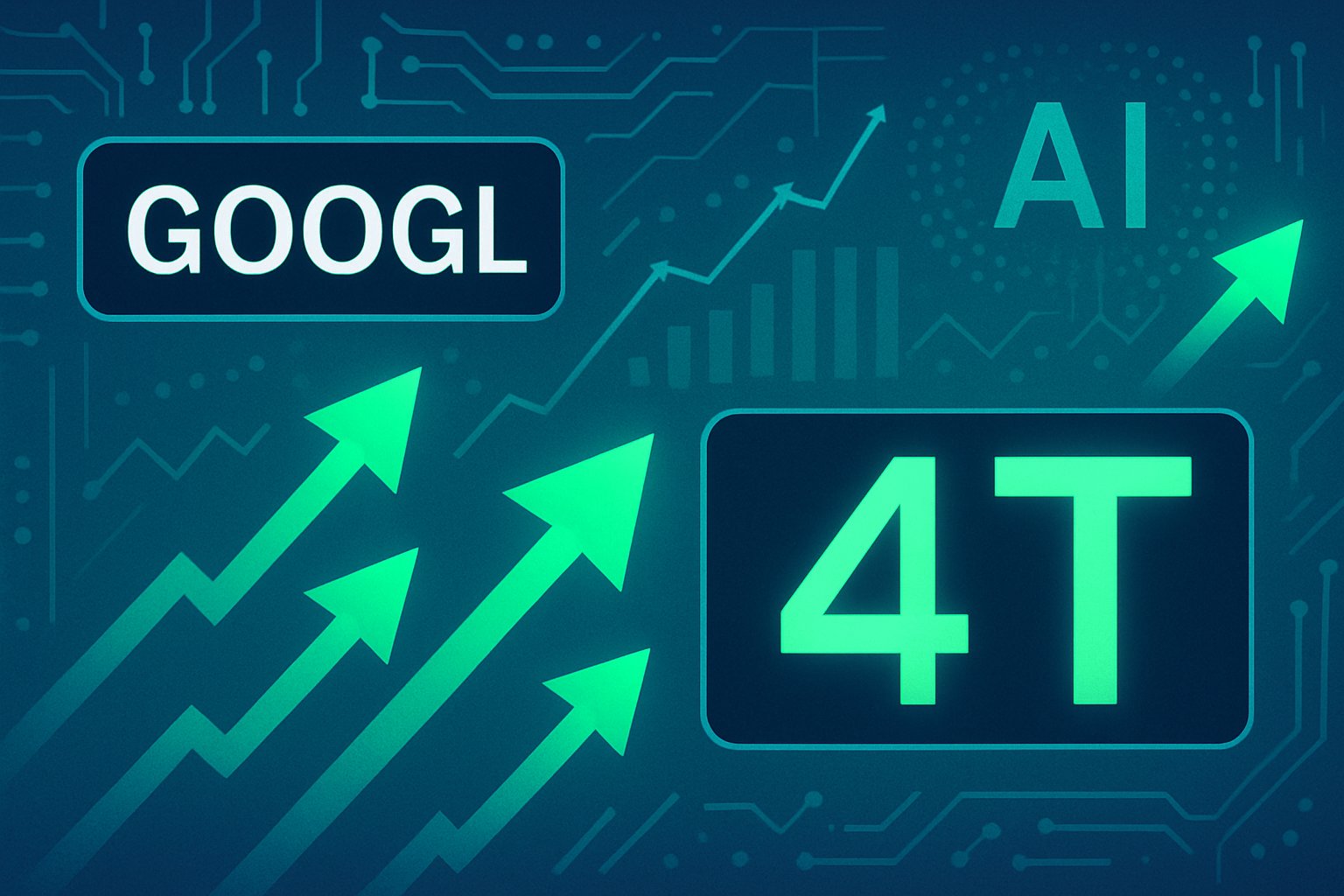
AI CERTS
22 hours ago
Alphabet’s Record Surge Pushes Market Cap Toward $4 Trillion
Berkshire Hathaway's fresh stake further stoked demand. Nevertheless, seasoned observers still recall dot-com excess warnings. Therefore, understanding the forces behind this ascent matters for technology leaders and portfolio chiefs.
Alphabet Record Price Surge
Alphabet's late-November trading produced new records. Additionally, Reuters logged the intraday peak at $315.90. Consequently, the equity closed within striking distance of the symbolic $4 trillion threshold. While the print stopped at $3.82 trillion, the psychological gap narrowed. Meanwhile, peers such as Nvidia, Apple, and Microsoft have flirted with similar territory. In contrast, Alphabet reached the marker later, yet with fewer splits than Apple.

Year-to-date, shares advanced nearly 70 percent. Furthermore, the climb outpaced the Nasdaq Composite by more than 25 percentage points. This outperformance underscored persistent AI Momentum across Big Tech. Nevertheless, some strategists noted stretched positioning indicators. They argued that the current Market Cap needs sustained earnings to justify the premium.
Key Drivers Behind Gains
Several catalysts converged to propel the Stock Rally. Firstly, Google Cloud margins expanded for three straight quarters. Secondly, the company showcased new TPU generations that promise lower inference costs. Moreover, cross-industry interest in renting Google silicon boosted revenue forecasts. Consequently, observers revised topline models upward.
Additionally, advertising cash flow remained robust despite macro headwinds. Search query volumes grew alongside YouTube Shorts engagement. Therefore, Alphabet funded aggressive buybacks without straining its balance sheet. Analysts argued that each dollar retired lowered the share float, nudging Market Cap higher even before new product releases.
Gemini 3 Launch Impact
Gemini 3 arrived on 18 November with multimodal prowess. Furthermore, the suite introduced agentic features that handle multi-step tasks across applications. Such capabilities reinforced investor belief in Google's AI leadership. Subsequently, media coverage framed Gemini as a credible rival to OpenAI's most advanced models.
Enterprises reacted quickly. Several design partners began piloting document summarization and video analytics using Gemini 3 APIs. Meanwhile, developers praised the new “Antigravity” toolkit for easing orchestration. Consequently, forecasts for premium cloud consumption improved. This acceleration of AI Momentum fed directly into optimistic valuation models, including the headline Market Cap target.
Berkshire Stake Validates Alphabet
Warren Buffett's conglomerate seldom buys high-growth technology. Nevertheless, its Q3 13F revealed 17.85 million Alphabet shares. Interactive Brokers analyst Steve Sosnick noted that many traders emulate Berkshire moves. Consequently, the filing created a momentum loop that pushed volume higher.
Moreover, value-oriented investors interpreted the purchase as a quality endorsement. In contrast, some skeptics viewed the disclosure as a lagging signal. However, the mere association added narrative heft during the November Stock Rally. Combined with Google’s product cadence, Berkshire's vote of confidence justified another leg in Market Cap expansion.
Competitive Landscape Shifts Fast
Nvidia still commands the AI accelerator spotlight. However, Google’s willingness to license TPUs to external parties threatens that dominance. Reports even suggested Meta explored Google silicon for its data centers. Consequently, supply chain diversification could pressure GPU pricing.
Meanwhile, Big Tech rivals Apple and Microsoft continue to chase platform integration. Nevertheless, Alphabet’s control over hardware, models, and distribution gives it an end-to-end stack. This integration may translate into margin leverage across Big Tech tiers. Therefore, bulls see room for the Market Cap to close the remaining $180 billion gap.
- Record close: $315.90 per share
- Approximate valuation: $3.82 trillion
- 2025 gain: nearly 70 percent Stock Rally
- Berkshire holding: 17.85 million shares
- Peers above $4T: Nvidia, Apple, Microsoft
Valuation Risks And Hedges
Lofty multiples evoke memories of the late-1990s. Analysts caution that AI spending remains capital intensive. Additionally, regulatory probes still loom in multiple jurisdictions. Consequently, any adverse ruling could compress advertiser margins and, by extension, Market Cap projections.
Therefore, prudent allocators pursue hedges. Some rotate into equal-weighted technology baskets. Others buy long-dated puts to cap downside. Moreover, they monitor cash burn at emerging AI startups to gauge bubble signals. Nevertheless, if revenue growth tracks current forecasts, Alphabet's Market Cap could defend higher altitudes.
Strategic Investor Takeaways
Institutional desks monitor three vectors. Firstly, they track AI Momentum through product release cadence. Secondly, they examine supply commitments for TPUs, GPUs, and related Big Tech infrastructure. Thirdly, they study antitrust dockets for signals on structural remedies. Collectively, these threads inform conviction sizing.
Professionals can deepen domain expertise through the AI Customer Service Strategist™ certification. Moreover, programs like this help leaders translate technical advances into revenue strategy. Consequently, workforce readiness will influence future capital flows across Big Tech ecosystems.
Finally, disciplined valuation frameworks still matter. Analysts suggest comparing free-cash-flow yield to implied growth. Nevertheless, many remain constructive while Gemini workloads scale. Therefore, they wait for the inevitable earnings print that pushes the headline Market Cap past $4 trillion.
Alphabet’s November surge reflects a complex blend of AI breakthroughs, strategic endorsements, and renewed demand for integrated cloud infrastructure. Furthermore, Berkshire’s entrance validated the narrative, while Gemini 3 expanded the technical moat. Nevertheless, regulatory questions and capital intensity temper exuberance. In contrast, diversified revenue pillars provide resilience missing from previous bubbles. Consequently, investors who align skills with product evolution will position themselves for the next re-rating. Therefore, explore accredited programs like the linked certification to strengthen analytical depth and stay ahead in an increasingly data-driven boardroom. Meanwhile, ongoing monitoring of cash flow trends will confirm whether lofty valuations remain justified.



